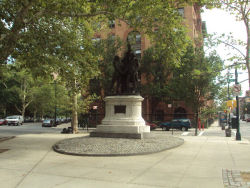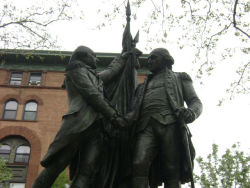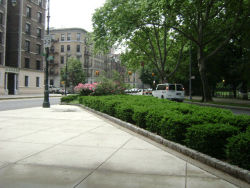Lafayette Square
Lafayette Square
Lafayette Square is named in honor of the prominent French statesman and military leader Marie Joseph Paul Yves Roch Gilbert Du Montier Lafayette (1757-1834). Also known as Marquis de Lafayette, he is best remembered for his role in the Revolutionary War. Sympathetic to the American cause, he aided the colonists through the provision of experienced military leadership. The Frenchman quickly became a favorite of General George Washington, who appointed him Major General in the Continental Army during 1777. The next year, Lafayette returned to France following the formal agreement of the France/United States alliance against Great Britain. Once in France, he actively lobbied for the allotment of increased military and financial aid for the Colonies. In 1780, Marquis de Lafayette returned to America and served valorously in the Virginia campaign, which forced the surrender of Lord Charles Cornwallis in 1781.
As a true proponent of democracy, Lafayette assumed a leading role in the French Revolution of 1789. He became a member of the National Assembly, from which position he prepared a bill of rights based on the American Declaration of Independence. He commanded the French National Guard and joined the Feuillants, a moderate political party that advocated a constitutional monarchy. He gained leadership of a French division in 1792 in the war against Austria. Chastised by the Jacobins within his unit (who were far more radical than the Feuillants) Lafayette fled to Flanders where Austrian authorities imprisoned him for five years. Upon his return to France, he avoided the dictatorial politics of Napoleon Bonaparte. Following Napoleon’s defeat at Waterloo, Lafayette resumed his political career as a member of the Chamber of Deputies in 1815 and from 1818 to 1824. He toured the United States in 1824 during which time Congress voted him a gift of $200,000 and a large tract of land. Marquis de Lafayette, the statesman and general, maintained the convictions of democracy, social equality, and religious freedom throughout the remainder of his life.
Manhattan Avenue, 114th Street, and Morningside Avenue bound Lafayette Square, which is located in the Morningside Heights section of Manhattan. The City of New York acquired this property by condemnation on July 28, 1870 along with the land used to build Morningside Park. The square contains large, shady sycamore trees and a monument entitled “Lafayette and Washington.” French sculptor Frederic-Auguste Bartholdi (1834-1904) designed the bronze statue, which depicts both figures on a marble pedestal, clothed in colonial uniforms, and shaking hands with the flags of their respective countries behind them. Famed publisher, Joseph Pulitzer (1847-1911) commissioned the sculpture based on the artist’s previous major accomplishment: the Statue of Liberty in the New York Harbor. Bartholdi completed the original “Lafayette and Washington,” which was dedicated in Paris in 1895. At the turn of the century, department store owner Charles Broadway Rouss bequeathed this fine replica to the residents of Morningside Heights.
Check out your park's Vital Signs
Clean & Safe
Green & Resilient
Empowered & Engaged Users
Share your feedback or learn more about how this park is part of a
Vital Park System



